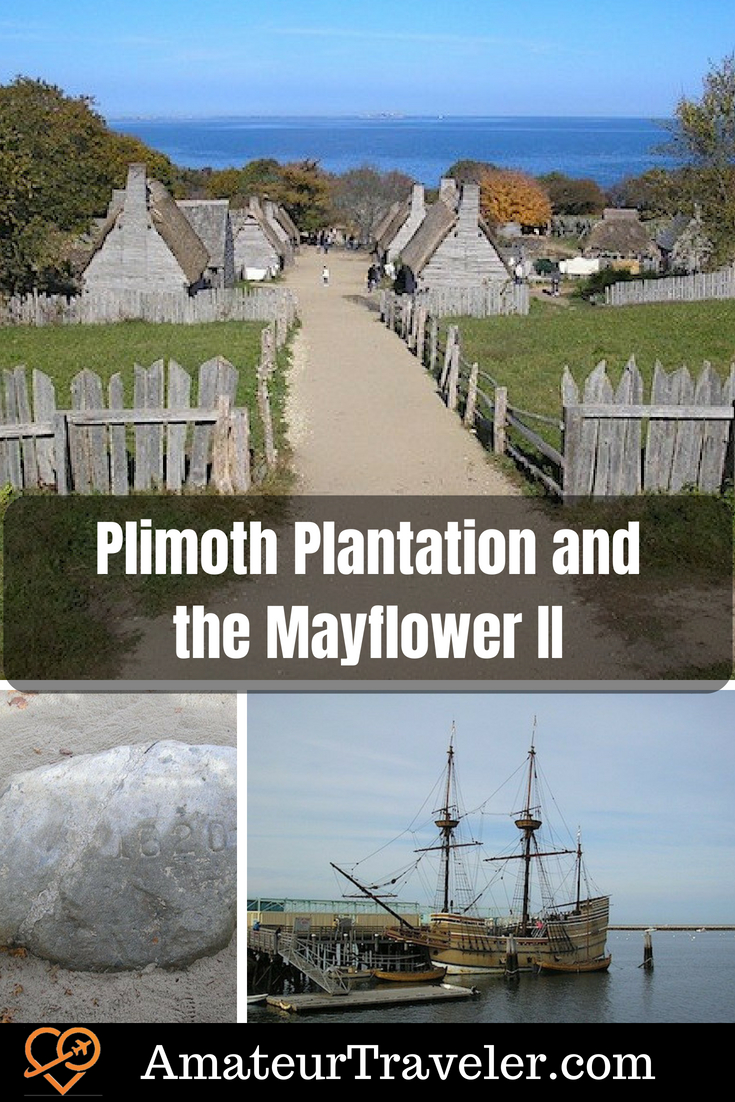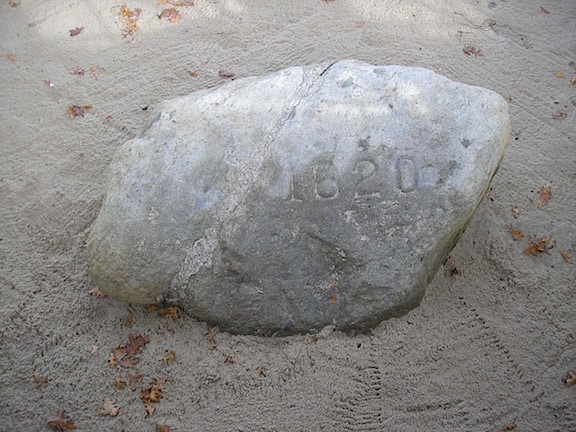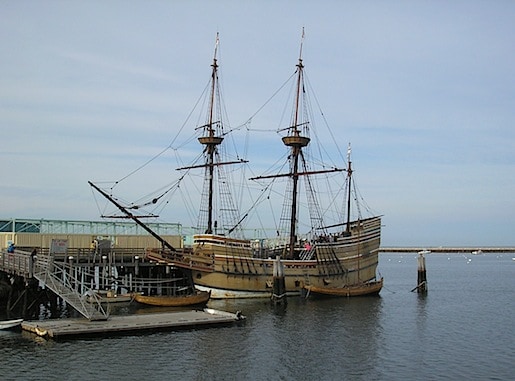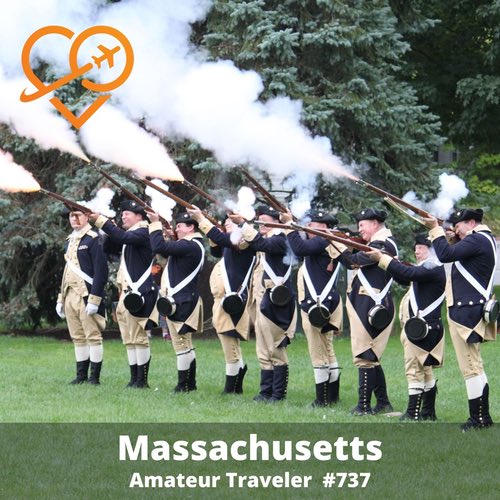Plymoth Plantation and the Mayflower II – Things to do in Plymouth, Massachusetts
categories: USA TravelEach year as an elementary school teacher, I have the opportunity to teach students the history and traditions associated with the United States Thanksgiving holiday. I often incorporate into my discussions of the holiday my fond memories of visiting the town of Plymouth, Massachusetts, as a child with my grandparents. This year on a journey through New England, I took a day to visit Plymouth in order to reacquaint myself with sites I saw years ago and visit other areas I missed. One place I did not get to see was the recreation of the Pilgrims’ settlement called the Plimoth Plantation. I also distinctly remember that I did not get to board the Mayflower. This year I was determined to visit both.
Plimoth Plantation (Plymouth Plantation)
Plimoth Plantation is a living history museum that recreates the Pilgrim settlement that was located on Leyden Street in the present town of Plymouth, Massachusetts. In 1947 Henry Hornblower II started this museum to tell the story of the “Pilgrims and their Native American neighbors.” His recreation began with a few buildings on the waterfront in the town of Plymouth in 1949. In 1958 the project was moved about 2.5 miles south of the town of Plymouth to its current location. The recreated settlement is spelled Plimoth because the second Governor of the Plymouth Colony, William Bradford, frequently used this spelling. It also helps to distinguish the museum from the original settlement.
The Plantation features a recreated Wampanoag Indian Village, a 17th Century English Village with a fort and meeting house, a Craft Center, a Visitor/Orientation Center, and the Nye Barn that provides information about the rare and minor breed animals found in the museum. Plimoth is a living history museum dedicated to showing the 17th-century lifestyle of the Pilgrims. All aspects of the museum from the trees, plants, houses, clothing, animals, and artifacts used by the interpreters have been designed to help visitors understand and experience life in the 17th century. Visitors are encouraged to ask questions and interact with the townspeople who portray actual residents of Plymouth in 1627, speak the language of the day, and express 17th-century viewpoints.
I visited Plimoth Plantation in late October, a few weeks before Thanksgiving, after the busy summer tourist season. I actually decided to go at this time of year because I thought there might be something special about visiting in the fall when the air was cooler and the foliage was in full color. An introductory film at the Visitor’s Center gave me a basic orientation on what was located at the site and how to best experience everything the plantation had to offer. The orientation also helps to create in the visitor’s mind the idea that this site was created to tell the story of two peoples, the Wampanoags and Pilgrims, and how their story become one through their interaction with each other. The museum role players give a very honest interpretation of this complex story that involves a clash of cultures. They speak openly about the fears, distrust, lack of understanding, and sometimes outright hostility that existed as well as the cooperation and exchange of ideas that occurred. The story is not as pristine and simple as often presented in history textbooks
The First Thanksgiving
A major question that seems to hang over the experience concerns the first Thanksgiving and what really happened? I was pleased to find out that the museum did not outrightly dismiss the first Thanksgiving as a commercialized American myth, but approached it in a thoughtful and historical way.
A special exhibit in the Visitor Center called Memory, Myth, and Meaning presents the traditions of the holiday along with the facts of what historians actually know happened in Plymouth between the Pilgrims and Native Americans. The exhibit also addressed the many famous paintings that celebrate the event and got to the core of the actual events that likely occurred between the Wampanoags and Pilgrims. I actually enjoyed this exhibit very much and found that the information really added to the experience of visiting the plantation.
Unfortunately, it appeared to me that only a few people took the time to view the artifacts and read the information regarding the facts and myth of Thanksgiving. Most headed for the other great American traditions of the snack bar and gift shop.
Plymouth
After about two hours of visiting Plimoth Plantation, I left wanting to know more so I headed to the town of Plymouth to further my experience. At the museum, I had purchased a combination ticket that included admission to the Plantation and the Mayflower II anchored at a wharf in Plymouth.
Plymouth Rock
After driving the few miles north to the town of Plymouth, I spent another hour viewing Plymouth Rock, the Mayflower II, and many of the monuments along the waterfront.
Mayflower II
The Mayflower II is an authentic seaworthy replica of the original boat that transported the Pilgrims to America. No one knows what happened to the original ship. The current reproduction sailed from England on April 20, 1957, to its current home in Plymouth Harbor. Interpreters help visitors understand the voyage of the Pilgrims and the hardships of sea travel. It does not take long to travel through the boat, because it is so amazingly small. Nonetheless, I was really happy to actually board this replica after missing the opportunity many years ago.
Pilgrim Hall Museum
Still not satisfied that I had experienced the full story, I further dedicated another hour visiting the Pilgrim Hall Museum, the oldest continuously operating museum in America. The museum was created to tell the story of the Pilgrims and the Plymouth Colony. Their collection contains actual artifacts owned and used by many of the Pilgrim settlers along with many famous paintings that depict the hardships of the Pilgrims and their celebration of the first Thanksgiving. There is also a very informative 15-minute film narrated by Nathaniel Philbrick and other historians that dramatically tells the story of the Pilgrims’ journey and the early years of survival of the Plymouth Colony.
I found that the Pilgrim Hall Museum went to great lengths to debunk some of the myths associated with the Pilgrims by presenting many factual details of their story. They highlighted the fact that the original Pilgrims were actually Separatists in their religious beliefs and not Puritan as the later settlers of the Massachusetts Bay Colony.
The museum also used their extensive collection of paintings and reproductions of clothing to clarify how the Pilgrims actually dressed. Many people wrongfully believe that Pilgrim men dressed in black breeches, square white collar and cuffs, wide buckled belts, and black steeple hats while Pilgrim women wore wide black skirts, white aprons, and dark capes. The museum displays pointed out that this was the traditional dress of the Puritans, not the Pilgrims. While most likely their everyday clothing simply reflected the natural color of the material they used, their religious beliefs did not object to them dressing in bright colorful colors such as brick red, green, beige, burgundy, blue, or yellow.

The story of how they overcame insurmountable odds to establish the settlement of Plymouth (aided by the Wampanoags), is the message that Henry Hornblower II felt was so important for us to understand. I found that even though many of the sites in Plymouth are actually recreations and replicas, and many of the stories surrounding the Pilgrims are more mythical than factual, it is actually possible to understand who they were and why they are such an important part of American folklore.
Conclusion
So this Thanksgiving as I sit down with my family to share our traditional Thanksgiving meal, I think I will have a much deeper appreciation of what originally occurred almost 400 years ago. I will also sit down with a better understanding of the complexities of our history and how different peoples from different parts of the world were brought together in a way that would forever change their lives. I am really glad that I took the time to return to Plymouth, Massachusetts, and I would encourage other fellow amateur travelers to visit and gain some insight into America’s early history.
Leave a Reply
Tags: article, massachusetts, Plimoth Plantation




 Middleton Place Historic Plantation and Gardens – Charleston, South Carolina
Middleton Place Historic Plantation and Gardens – Charleston, South Carolina Travel to Massachusetts – Episode 737
Travel to Massachusetts – Episode 737 6 National Parks in Massachusetts Near Boston Worth Seeing
6 National Parks in Massachusetts Near Boston Worth Seeing Boston, Massachusetts in the Summer
Boston, Massachusetts in the Summer

